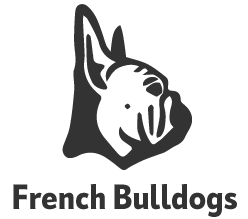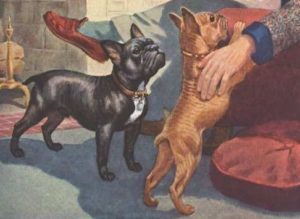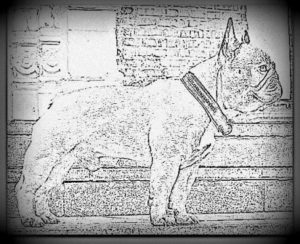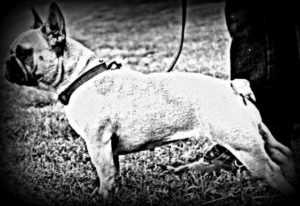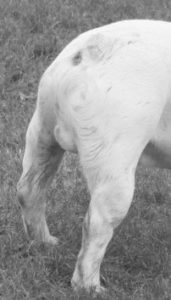We try to keep the breed standard in general, but given that our health is paramount, we aim for a slightly longer snout, larger nostrils (better breathing) and longer back with a small tail (free movement) as they originally belong to see.
Many breeds including the French Bulldog are bred too extreme, passed on in terms of type and as long as the breed standard is not adapted worldwide on certain important points the breed will not change completely.
However, there are kennel clubs and breed clubs in various countries that see the health problem that the French Bulldog has to deal with and there are clear changes on the websites visible, even at shows more attention is paid to health.
But once again the breed standard has to be adjusted officially worldwide, once again to get the breed completely healthy again.
This is our example type French Bulldog from the past (around 1900) a healthy type as they should look and it must remain a French Bulldog.
The first race club was founded in Paris in 1880. The first registered registration dates from 1885 and the first standard was drawn up in 1898, the year in which the “Société Centrale Canine” recognized the French Bulldog as a breed. The first dog exhibition was held in 1887.
The standard was changed in 1931 – 1932 and 1948, rewritten in 1986 by H.F. Reant and R. Triquet (published by the F.C.I. in 1987) and then by the board of the French Bulldoggenclub in collaboration with R. Triquet. Then in 1994 by Violette Guillon (F.C.I. publication 1995) and in 2012 by the board of the French Bulldogen Club of the ‘parent association’ in France.
FCI-St. N ° 101 / 17.04.2015
GENERAL APPEARANCE
Typically a small size dog-like. Small powerful dog, short, stocky in all its proportions, short-haired, with a snub nose, standing ears and with a naturally short tail. He must have the appearance of an active animal, intelligent, very muscular with a compact structure and a solid bone structure.
In both the overall harmony, the appearance, and the movement, there must be no exaggeration in any part with respect to other parts.
IMPORTANT PROPORTIONS: the length of the body – between the tip of the shoulder and the sit leg – is slightly longer than the height of the withers. The length of the muzzle is about 1/6 of the total length of the head.
BEHAVIOR – CHARACTER
Cozy, playful, cheerful, possessive and a smart companion dog
HEAD: The head must be strong, broad and square; the scalp forms symmetrical folds and wrinkles, without exaggeration.
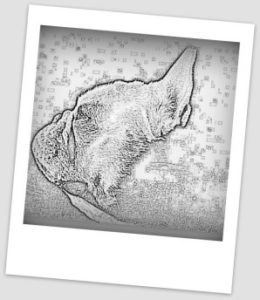
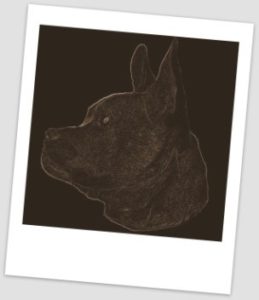
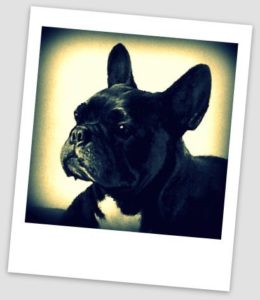
Type of Breed standard (too short) Type Terrier / Greyhound (too long) Type clear French Bull (but with more nose)
SKULL AREA: Skull – Wide, almost flat from ear to ear, convex forehead. The eyebrows jump forward and are separated by a specially developed groove between the eyes. The groove may not continue on the forehead. The back of the skull is little developed.
Stop: accentuated.
THE FACE
The head of the French Bulldog is characterized by a receding massive muzzle as well as a slight to average backward receding nose ridge. The nose is slightly raised ‘snub nose’.
Nose: black, broad,, snub nose, well opened and symmetrically placed nostrils, sloping backwards. However, the sloping nostrils as well as the snub nose must always allow normal nasal breathing.
Muzzle: very short, broad, exhibits concentrically symmetrical folds.
Lips: thick, a little slack and black. The upper lip connects to the lower lip in the middle and completely covers the teeth. The profile of the upper lip is hanging and round. The tongue should never be visible if the dog is not excited.
Jaws / teeth: broad, powerful. The lower jaw protrudes from the upper jaw and bends upwards. The lower incisor arch is rounded. The jaws must not show a lateral deviation or twisting. The opening between the incisors of the upper and lower jaw is not strictly unlimited, however, the essential condition remains that the upper lip and the lower lip close together so that they completely cover the teeth.
The incisors of the lower jaw stand in front of the incisors of the upper jaw. Sufficiently developed cutting and canine teeth and complete teeth desired.
Cheeks: well developed.
Eyes: clearly visible eyes, cheerful expression, low placed, fairly far from the muzzle and ears, dark colored, rather large, round in shape, show no white whatsoever (whites) when the dog is looking straight ahead. The edges of the eyelids must be black.
Ears: medium-sized, broad at the base and round at the top. High on the head, but not too close together, carried upright. The ear opening is completely visible from the front. The skin should feel soft and fine.
Neck: short, powerfully slightly curved, without dewlap, widens towards the shoulders.
BODY
Topline: gradually goes up, but not exaggerated, from the withers to the loins. This form, also known as roach-back, is a typical characteristic.
Type of breed standard (too short in the back) Type healthy built (longer back)
Back: broad and muscular, steady, not loose.
Loins: short, broad and rounded.
Cross: well descending.
Chest: barrel-shaped and deep (up to just below the elbows). very well-curved ribs so called ‘ton-shaped’.
Fore chest: broad and square, seen from the front.
Belly and flanks: raised but not like a greyhound.
Tail: naturally short, ideally long enough to cover the anus, set low, quite straight at the base and narrowing towards the tip. A “broken”, “knotted”, “broken” or a relatively long tail reaching no further than the heel is allowed. The tail should be worn low. Even in action, it must remain below a horizontal line.
Breed standard (Good tail) Breed standard (Good tail) No tail (wrong)
LIMBS
PRE-HAND: General appearance: front legs straight as seen from both the side and the front.
Shoulders: well reclined
Upper arms: Short and thick, muscular, slightly curved.
Elbow: touching and tight against the body.
Forearms: short, straight and muscular.
Carpus (wrist joint): solid, short
Metacarpus (middle leg): seen short and slightly curved sideways.
Feet: round, compact, small, so-called “cat foot”, slightly turned outwards. The toes are well closed, short nails, thick and black.
BACK HAND: General appearance: The hind legs are strong and muscular, slightly longer than the foreleg so that the hindquarters are somewhat higher. The legs are straight both from the side and from the rear.
Thigh: muscular, firm
Jump: fairly low, neither too angled nor too straight. ankle joint:
Foot root and metatarsal: firm and short.
Feet: round, compact, neither inwards nor outwards.
Corridors: The limbs move parallel to the center line of the body both from the side and from the front. Free, powerful and smooth movement.
Skin: tight
COAT
Coat: smooth coat, contiguous, shiny and soft, without undercoat.
Colors: fawn, brindle or not, with or without white spots
Colored coat: Brindled: fawn coat characterized by mediocre, transverse dark currents creating a ‘tigery’ effect. Strongly poured coats may not completely cover the fawn ground color. A black mask may be present. Limited white markings are allowed.
Fawn: uniform colored coat, from light to dark fawn, sometimes a lighter color of the inner parts of the body occurs. With or without black mask with masked dogs being preferred. Occasionally with limited white markings.
Coat with white markings: Brindled with medium or predominant white markings: so-called ‘fur’. The markings are ideally distributed over the entire dog. Some spots on the skin allowed.
Fawns with medium or predominant white markings: so-called ‘fawn fur’. The spots ideally divided over the entire dog. Some spots on the skin are tolerated.
Regardless of the coat color, the nose should always be black, never blue or brown. All white specimens are allowed if the edge of the eyelids and the nose are black. However, this color should not be sought in view of the risk of deafness.
SIZE & WEIGHT
Withers height: males 27-35 cm – females: 24-32 cm. A deviation of 1 cm above or below the standard is permitted.
Weight: males 9-14 kg – females 8-13 kg. 500 grams heavier than the standard weight is allowed if it is a typical one.
FAULTS
Anything different from the above should be considered as a deviation and will have to be punished exactly according to the severity of the deviation and the effect on the dog’s health and well-being.
- Strongly spotted in dogs with brindled white fur
- Fawn and white coat strongly red mottled
- Fawn-colored dogs with deep black stripe across the back
- White ” stockings ” with fawn and brindle dogs
- Light colored nails
SERIOUS DEROGATIONS
- Overtypical, exaggerated breed characteristics
- Muzzle too long or excessively short
- Visible tongue with closed mouth
- Light eyes (bird of prey)
- Horizontal back lines, from withers to the loins
- Abundant the pigmentation of the lips, nose, eyelids, the edge that may never be completely depigmented
- Tang bite
DISQUALIFYING DEROGATIONS
- Aggressive or overly shy
- Any dog with obvious physical or behavioral abnormalities must be disqualified
- Absence of ‘type’: insufficient breed typical characteristics with the result that the dog does not resemble other specimens of the
- breed
- Fully closed nostrils
- Rotation or lateral deviation of the jaw with the result that the tongue is constantly visible
- Dog whose lower incisors are positioned behind the upper incisors (top fore)
- Dog with permanently visible canines while the mouth is closed.
- Heterochromia (two-toned eyes or two different colored eyes)
- Different nose color than black
- Ears not worn upright
- Taillessness or ingrown tail
- St Hubert claw on the hind legs
- Inverted heel
- Long or thread-haired or woolly coat
- Color not as described in the standard: black, black with fawn markings (black & tan) and all dilutions of black with or without
- white markings
- Size and weight outside the limits of the standard
- Breathing problems
- Deafness
N.B .:
Males must have two apparently normal testicles fully descended into the scrotum
Only functional and clinically healthy dogs with typical breed construction should be used for breeding
